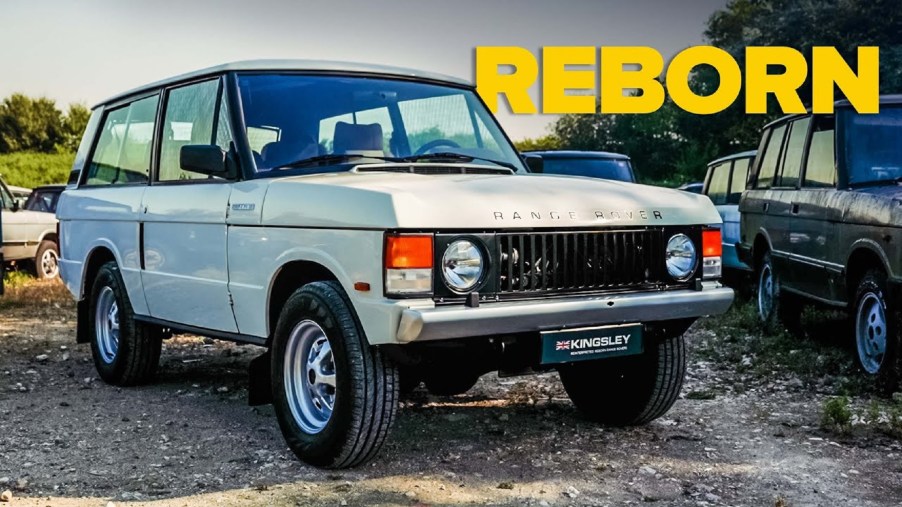
Kingsley Re-Engineers the Range Rover Into an Ideal Classic Commuter
Vintage Land Rovers of all kinds might be capable off-road machines with rugged looks, but they’re not exactly reliable. And despite their luxury status, that applies just as much to classic Range Rovers. However, there’s at least one way to fix this: restomod them. What Kingsley Cars does, though, is arguably better described as ‘re-engineering.’
Kingsley Cars lets Range Rover Classics keep living even in low-emission zones

UK-based Kingsley Cars offers three different flavors of restored first-gen Range Rovers. The KA Series is the ‘entry-level’ model in that it’s intended to be the basis for future work. However, even these SUVs are partially dismantled to locate and remove rust and replace things like rubber gaskets, seals, wiring, and floor panels. The shop also repaints the Range Rover Classic, refurbishes various exterior parts, and services the powertrain.
The next rung on the Kingsley Cars Range Rover ladder is the KC Series. These SUVs are stripped to bare metal to remove rust and, if needed, fabricate and weld in new body panels. The shop then straightens all the panels and chassis components, installs new wiring looms, adds modern corrosion protection, and repaints everything. After that, it installs a new interior and goes through the powertrain, refurbishing and replacing virtually everything.
Kingsley Cars goes even further with its KR Series Range Rover Classics, though. The KR Series gets the same rebuilding treatment as the KC models. However, these classic SUVs don’t retain their original powertrain components beyond the 4WD system and transfer case. While those get refurbished, Kingsley replaces the original engine with a modern fuel-injected one hooked to an equally modern transmission.
As a result, the older Range Rover Classics restored this way can freely travel within London’s ultra-low-emissions zone, Top Gear reports. And that means, theoretically, classic SUVs like this can keep going even as Europe starts banning or limiting internal-combustion cars.
But the modern engine doesn’t just help keep the vintage luxury SUV going in the face of incoming legislation. Along with the other modifications and improvements Kingsley Cars makes, it turns the Range Rover Classic into the SUV it arguably should’ve been from the start.
The KR Range Rover Classic is way faster than stock
Originally, the most powerful engine Land Rover offered in the Range Rover Classic was a 4.2-liter Rover V8. But even after it gained fuel injection in 1984, it only made 155 hp.
In comparison, the 4.6-liter fuel-injected Rover V8 Kingsley Cars puts in the KR Series makes 280 hp, Hagerty says. And that’s just the ‘base’ engine; the ‘High Torque’ version has 310 bhp. Also, although both Rover V8s come with four-speed automatics, a five-speed manual is available. The optional 430-bhp GM LS V8, though, only comes with a six-speed automatic.
However, even in base form, the KR Range Rover Classic goes 0-62 mph in 7.0 seconds. True, it’s not as fast as the latest supercharged Range Rovers. But it’s still fast enough to keep up with modern traffic, which can’t exactly be said for the original version, Top Gear notes. And thanks to in-house-designed slotted and drilled four-wheel discs, it stops better than the original, too. Also, fun fact: even the optional larger rotors still fit behind the original 16” alloy wheels.
With modern power, quality, and reliability, Kingsley Cars’ Range Rover Classic is a vintage luxury SUV you can genuinely daily-drive

The KR Series Range Rover Classic also handles significantly better than it did back in the day. For one, Kingsley updates the springs and shocks and rebuilds the steering box. But it also offers a Fast Road Handling Pack with a lower ride height, upgraded shocks and springs, and actual anti-roll bars. As a result, the SUV is utterly unlike the original version in that it, well, actually handles—and well, Hagerty reports. However, thanks to all the extra welds and restoration work, going over bumps doesn’t rattle the cabin.
Speaking of the cabin, it’s yet another significant upgrade Kingsley Cars brings to the Range Rover Classic. The shop soundproofs it, installs new door seals, and refurbishes all the seats, interior trim pieces, and materials. You can stick with Nappa leather just on the seats or throughout the entire interior, even the parcel shelf. And it “looks, feels, and smells amazing,” Carfection says.
The SUV also gets new wool carpets and electric window regulators, a rebuilt heating system, and a working A/C. Also, a rearview camera and an Alpine head unit. Customers can order a 700W JL Audio seven-speaker system, too, as well as Apple CarPlay.
The sum of all these upgrades is an SUV that looks and is a Range Rover Classic but behaves like something significantly newer. It absorbs road imperfections with aplomb but doesn’t wallow around road bends. The V8 delivers a wonderful burble but also usable power and plenty of low-end torque. True, the steering isn’t the sharpest, braking still requires some forethought, and a modern Velar is arguably even more luxurious. But the KR wraps vintage style and modern comfort in a package made to today’s manufacturing standards. And that means you can enjoy driving it every day.
How much does one of these classic SUVs cost?
Admittedly, all this classic style and modern luxury come at a price even higher than a 2022 Range Rover. A ‘standard’ KR Series starts at roughly $170K, Top Gear says. Add enough options, and you’re looking at a $230,000 classic SUV, Hagerty notes.
It’s worth noting that pristine Range Rover Classics cost less than $60,000 these days, Hagerty reports. However, they still require quite a bit of work to avoid electrical, suspension, and bodywork issues, Car and Driver says. And even then, they’re still old SUVs.
What the KR Series does, though, is keep the good parts of that statement and remove almost all of the bad parts. And for some, that might be worth the price tag.
Follow more updates from MotorBiscuit on our Facebook page.


